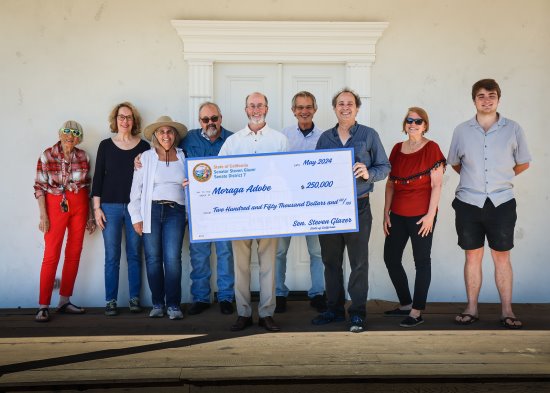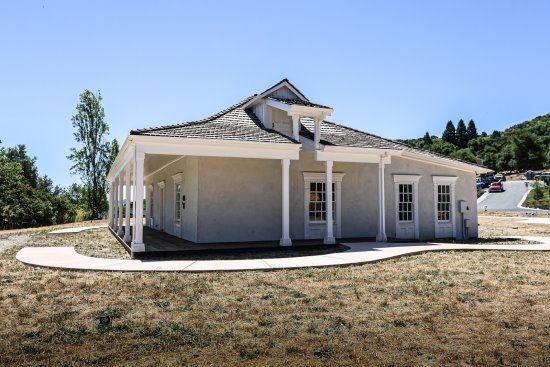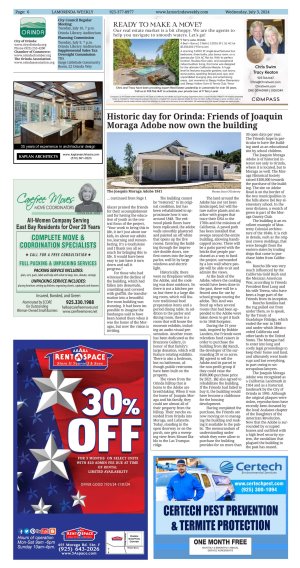| | Published July 3rd, 2024
| Historic day for Orinda: Friends of Joaquin Moraga Adobe now own the building
| | | By Sora O'Doherty |  | | State Senator Steve Glazer, center, presents a check to the Directors of the Friends of the Joaquin Moraga Adobe. From left to right, Bobbie Landers, Margaret Beck, Teresa Long, Lance Beeson, Jeff Boero, Kent Long, Tania DeGroot, and Peter Capri. Photo Sora O'Doherty |
Although the building isn't quite ready to regularly open to the public, the Friends of the Joaquin Moraga Adobe held a ribbon cutting ceremony and preview on Saturday June 29, to celebrate the purchase of the building. Visitors, including Orinda Mayor Darlene Gee, were allowed to enter the building and admire the amazing rehabilitation of the oldest existing building in Contra Costa County. The ribbon was cut by Bobbie Landers, who instigated the drive to save the Adobe, and Board member Lance Beeson, who is a direct descendant of the Moraga family.
 Unable to attend the Saturday ceremony, State Senator Steve Glazer came on the preceding Friday to present to the board of the Friends a check for a $250,000 State Park grant, to reimburse half of the purchase price of the building. Glazer praised the friends for their accomplishment and for having the education of youth as the central focus of the project, "Your work to bring this to life, it isn't just about our kids, its about our adults too, learning and remembering. It's a touchstone and I thank you all so much for bringing this to life. It would have been easy to just have it torn down and call it progress."
Unable to attend the Saturday ceremony, State Senator Steve Glazer came on the preceding Friday to present to the board of the Friends a check for a $250,000 State Park grant, to reimburse half of the purchase price of the building. Glazer praised the friends for their accomplishment and for having the education of youth as the central focus of the project, "Your work to bring this to life, it isn't just about our kids, its about our adults too, learning and remembering. It's a touchstone and I thank you all so much for bringing this to life. It would have been easy to just have it torn down and call it progress."
 For those who had witnessed the decline of the building, which had fallen into desuetude, crumbling and covered with graffiti, the transformation into a beautiful five room building was stunning. It had been impossible to imagine the fandangos said to have been hosted there when it was the home of the Moragas, but now the vision is inviting.
For those who had witnessed the decline of the building, which had fallen into desuetude, crumbling and covered with graffiti, the transformation into a beautiful five room building was stunning. It had been impossible to imagine the fandangos said to have been hosted there when it was the home of the Moragas, but now the vision is inviting.
 The building cannot be "restored," to its original condition, but has been rehabilitated to approximate how it was around 1848. The redwood plank floors have been replicated, the adobe walls smoothly plastered and painted an off white that opens up the five rooms. Entering the building through the impressive double doors, one first comes into the large parlor, well lit by large windows and electric light.
The building cannot be "restored," to its original condition, but has been rehabilitated to approximate how it was around 1848. The redwood plank floors have been replicated, the adobe walls smoothly plastered and painted an off white that opens up the five rooms. Entering the building through the impressive double doors, one first comes into the large parlor, well lit by large windows and electric light.
 Historically, there were no fireplaces within the Adobe, and the cooking was done outdoors. So there is not a kitchen per se, but there is a large dining room, which will feature traditional food preparation items and a period dining table. In addition to the parlor and dining room, there is a room that will house the museum exhibits, including an audio-visual presentation. Another room has been dedicated as the Bruzzone Gallery, in honor of that family's large donation, which will feature rotating exhibits. There is also a bedroom, but no bathroom, although public restrooms have been built on the property.
Historically, there were no fireplaces within the Adobe, and the cooking was done outdoors. So there is not a kitchen per se, but there is a large dining room, which will feature traditional food preparation items and a period dining table. In addition to the parlor and dining room, there is a room that will house the museum exhibits, including an audio-visual presentation. Another room has been dedicated as the Bruzzone Gallery, in honor of that family's large donation, which will feature rotating exhibits. There is also a bedroom, but no bathroom, although public restrooms have been built on the property.
 The views from the Orinda hilltop that is home to the Adobe are breathtaking. When it was the home of Joaquin Moraga and his family, they could see almost all of their property from the hilltop. Their rancho extended from Orinda into Moraga, and Lafayette. Today, standing in the open doorway or on the porch, one gets a sweeping view from Mount Diablo to the Las Trampas ridge.
The views from the Orinda hilltop that is home to the Adobe are breathtaking. When it was the home of Joaquin Moraga and his family, they could see almost all of their property from the hilltop. Their rancho extended from Orinda into Moraga, and Lafayette. Today, standing in the open doorway or on the porch, one gets a sweeping view from Mount Diablo to the Las Trampas ridge.
 The land around the Adobe has not yet been landscaped, but will feature native plants and an arbor with grapes that trace their DNA to the 1700s and the missions of California. A paved path has been installed that sweeps around the entire building, allowing handicapped access. There will be a patio paved with the bricks that people purchased as a way to fund the project, surrounded by a low wall where people will be able to sit and admire the views.
The land around the Adobe has not yet been landscaped, but will feature native plants and an arbor with grapes that trace their DNA to the 1700s and the missions of California. A paved path has been installed that sweeps around the entire building, allowing handicapped access. There will be a patio paved with the bricks that people purchased as a way to fund the project, surrounded by a low wall where people will be able to sit and admire the views.
 At the back of the Adobe, where the cooking would have been done in the past, there will be a fenced area for use by school groups touring the adobe. This land was freed up when several rooms that had been appended to the Adobe were taken down to get it back to its 1848 footprint.
At the back of the Adobe, where the cooking would have been done in the past, there will be a fenced area for use by school groups touring the adobe. This land was freed up when several rooms that had been appended to the Adobe were taken down to get it back to its 1848 footprint.
 During the 15 year task, inspired by Bobbie Landers, the Friends were relentless fund raisers in order to purchase the building from J&J Ranch, the developer of the surrounding 20 or so acres. J&J agreed to sell the Adobe and its parcel to the non-profit group if they could raise the $500,000 purchase price by 2021. J&J also agreed to rehabilitate the building. If the Friends had failed to buy it, the building would have become a clubhouse for the housing development.
During the 15 year task, inspired by Bobbie Landers, the Friends were relentless fund raisers in order to purchase the building from J&J Ranch, the developer of the surrounding 20 or so acres. J&J agreed to sell the Adobe and its parcel to the non-profit group if they could raise the $500,000 purchase price by 2021. J&J also agreed to rehabilitate the building. If the Friends had failed to buy it, the building would have become a clubhouse for the housing development.
 Having completed the purchase, the Friends are now moving on to managing the building and making it available to the public. The memorandum of understanding under which they were allow to purchase the building provides for no more than 30 open days per year. The Friends hope in particular to have the building used as an educational site by school children.
Having completed the purchase, the Friends are now moving on to managing the building and making it available to the public. The memorandum of understanding under which they were allow to purchase the building provides for no more than 30 open days per year. The Friends hope in particular to have the building used as an educational site by school children.
 The Joaquin Moraga Adobe is of historical interest not only to Orinda, where it is located, but to Moraga as well. The Moraga Historical Society raised $100,000 towards the purchase of the building. The site on Adobe Road is on the border of the two municipalities in the hills above Del Rey elementary school. In the near distance, a swatch of green is part of the Moraga County Club.
The Joaquin Moraga Adobe is of historical interest not only to Orinda, where it is located, but to Moraga as well. The Moraga Historical Society raised $100,000 towards the purchase of the building. The site on Adobe Road is on the border of the two municipalities in the hills above Del Rey elementary school. In the near distance, a swatch of green is part of the Moraga County Club.
 The building is an excellent example of Monterey Colonial architecture of the 1840s. It is rich in details, such as the original crown moldings, that were brought from the eastern states by trading ships that came to purchase hides from California.
The building is an excellent example of Monterey Colonial architecture of the 1840s. It is rich in details, such as the original crown moldings, that were brought from the eastern states by trading ships that came to purchase hides from California.
 Rancho life was very much influenced by the California Gold Rush and the Mexican American War, according to Friends President Kent Long and his wife Teresa, who have been a huge part of the Friends from its inception.
Rancho life was very much influenced by the California Gold Rush and the Mexican American War, according to Friends President Kent Long and his wife Teresa, who have been a huge part of the Friends from its inception.
 Rancho families had the rug pulled out from under them, so to speak, by the Treaty of Guadalupe Hidalgo, which ended the war in 1848 and under which Mexico ceded California and other lands to the United States. The Moragas had to enter into long and costly legal proceedings to keep their home and land, and ultimately went bankrupt and lost everything, in part owing to unscrupulous lawyers.
Rancho families had the rug pulled out from under them, so to speak, by the Treaty of Guadalupe Hidalgo, which ended the war in 1848 and under which Mexico ceded California and other lands to the United States. The Moragas had to enter into long and costly legal proceedings to keep their home and land, and ultimately went bankrupt and lost everything, in part owing to unscrupulous lawyers.
 The Joaquin Moraga Adobe was recognized as a California Landmark in 1954 and as a historical landmark by the City of Orinda in 1995. Although the original plaques were stolen, reproductions have recently been donated by the local Acalanes chapter of the Daughters of the American Revolution. Now that the Adobe is surrounded by occupied homes and outfitted with a high level security system, the vandalism that plagued the building in the past has ceased.
The Joaquin Moraga Adobe was recognized as a California Landmark in 1954 and as a historical landmark by the City of Orinda in 1995. Although the original plaques were stolen, reproductions have recently been donated by the local Acalanes chapter of the Daughters of the American Revolution. Now that the Adobe is surrounded by occupied homes and outfitted with a high level security system, the vandalism that plagued the building in the past has ceased. |
 | | | | | | | | | | | | |




